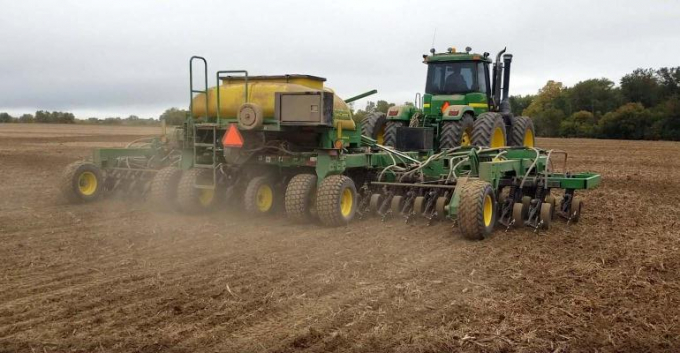November 27, 2025 | 22:26 GMT +7
November 27, 2025 | 22:26 GMT +7
Hotline: 0913.378.918
November 27, 2025 | 22:26 GMT +7
Hotline: 0913.378.918

Planting wheat in a research trial last fall. Photo: FP
With input costs biting away at margins, is it time to put some of your acreage to work making money with two crops in 2022. The profit potential is compelling:
-75 bu. per acre wheat yields X $7 (Jul22 forward contract is $7.42) = $525/acre revenue.
-43 bu. per acre soybean yields X $12 (Nov22 forward contract is $12.46) = $516/acre revenue.
Of course this equation assumes a lot of good things will happen, mainly, that weather or other issues don’t ding yields. But these yield estimates are fairly conservative, even for double crop soybeans.
And prices? Well, you could risk it and hope these prices will still be there next July and fall. Or you can use a simple risk management tool to lock in profit now.
Let’s start with the need to protect those high prices for next year’s harvests of wheat and soybeans. Recent spikes in fertilizer prices added another $10 per acre in corn costs, bringing total price increases to 45% since spring, according to our recent analysis. That’s enough to knock 35 cents per bu. off operating margins for 2022 corn – resulting in more soybeans going in the ground next spring. That higher soy acreage, combined with Brazil adding 2 million more soy acres, could overwhelm the market by next fall.
“Anhydrous is a big issue, maybe as much next fall as this next spring,” says Matt Bennett, a central Illinois grain farmer and market analyst with AgMarket.Net. “That’s driven by a fear in the industry that there is going to be fertilizer shortages. Several countries are talking about energy shortages, and you don’t just pull anhydrous out of the ground; you have to use some energy to make it.
“So, if you’re looking at double the cost of nitrogen, it’s pretty tempting to plant more beans,” says Bennett. “Then you look at what wheat prices are doing now. Wheat followed by beans is quite the performer.”
To be sure, there are still costs associated with planting two crops for 2022 harvest. University of Illinois 2022 crop budgets for Southern Illinois pencil in $137 per acre fertilizer costs for wheat, and $29 per acre for soybean fertilizer. Seed costs will run nearly $50 per acre for each crop.
Still, current futures prices should cause more drills to come out of the machine shed this fall.
“It’s crazy what some people can make, planting wheat followed by beans,” says Bennett. “You can lock in an incredible income.”
One of the simplest things you can do now is write an HTA (hedge-to-arrive) contract for wheat for next July, and also for soybeans for next fall. You hedge that crop without any margin call.
“For a producer who doesn’t want a hedge account, you’ll probably pay 8 to 10 cents a bu. to the elevator to write an HTA on $7.45 wheat,” explains Bennett. “So what? How many times have you been able to lock in $7.35 per bu. wheat when you’re planting? It’s not that often.”
You can also consider an options strategy, says Bennett. “For soybeans you can buy a Nov22 $12 put, sell a $10 put and sell a $14 call, to help finance the purchase of the $12 put,” he says. “Essentially, we’re locking in $12 beans for around 10 cents per bu. cost. That gives some assurance that hey, if the market gets hot and runs up to $14 per bu., I’m still participating in that rally. Yet, you still have a strong floor underneath you.”
AgMarket.net has been recommending clients forward contract 50% of next year’s soybean production – an aggressive stance, to be sure. But to Bennett it’s a no-brainer.
“It is, after all, a futures market, and we have no idea what will happen in South America, but they’re adding 2 million acres of soybeans this year,” he says. “And with fertilizer prices the way they are it looks like there will be a lot of incentives to plant beans next year.
“In the end, $12.60 beans are pretty hard to pass up,” he says. “As a producer how can you go wrong? You have to work pretty hard not to make money at those prices.”
(Farm Progress)

(VAN) A new study reveals how the simultaneous effects of ocean acidification, salinity and loss of oxygen are making the world more fragile.

(VAN) Hopes are growing that the creation of the first 3D turkey gut model could be a turning point in the battle against the virulent blackhead disease.

(VAN) Tyson, America’s biggest meat supplier, plans to shutter one of its largest beef processing plants as the industry continues to struggle with low cattle supplies and political pressure from Washington.

(VAN) New FAO study shows how digital solutions are empowering farmers and fishers to prevent losses and build resilient agrifood systems.

(VAN) Brazil's COP30 presidency pushed through a compromise climate deal on Saturday that would boost finance for poor nations coping with global warming but that omitted any mention of the fossil fuels driving it.

(VAN) Poultry farmers in the UK have been warned that they could face one of the worst winters yet for bird flu.

(VAN) Prices of main-crop paddy have risen sharply, with jasmine rice hitting 16,100 baht per tonne — the highest level in years.